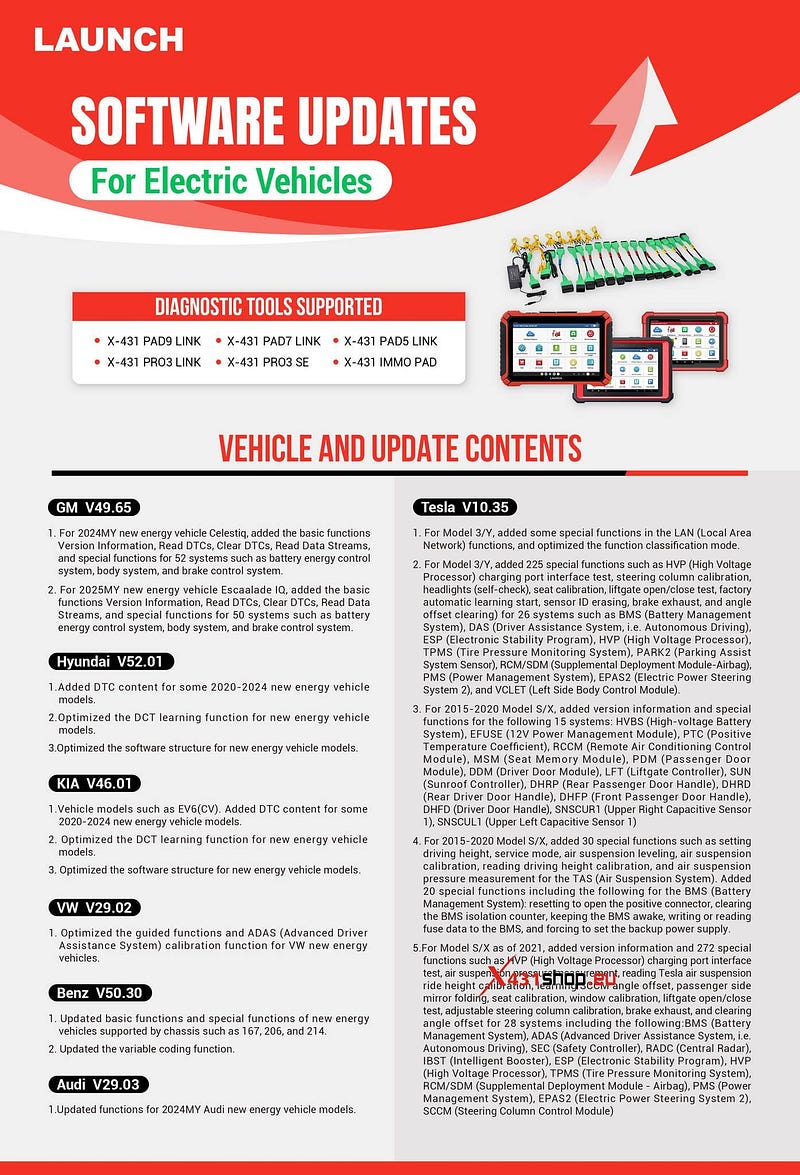LAUNCH-X431 Diagnostic Software Update For Electric Vehicles (June 2024)
LAUNCH-X431 latest electric vehicle diagnostic software was released on June 28, 2024, covering many vehicle brands. The following is a detailed update content.
This electric vehicle diagnostic software update is applicable to the
following LAUNCH-X431
tools:
X-431 PAD9 LINK, X-431 PAD7 LINK, X-431 PAD5 LINK
X-431 PR03 LINK, X-431 PR03 SE
X-431 IMMO PAD
Software updates applicable to each vehicle brand:
GM V49.65
1. For 2024MY new energy vehicle Celestiq,
added the basic functions Version Information, Read DTCs, Clear DTCs, Read Data
Streams, and special functions for 52 systems such as battery energy control
system, body system, and brake control system.
2. For 2025MY new energy
vehicle Escalade IQ, added the basic functions Version Information, Read DTCs,
Clear DTCs, Read Data Streams, and special functions for 50 systems such as
battery energy control system, body system, and brake control system.
Hyundai V52.01
1. Added DTC content for some 2020–2024
new energy vehicle models.
2. Optimized the DCT learning function for new
energy vehicle models.
3. Optimized the software structure for new energy
vehicle models.
KIA V46.01
1. Vehicle models such as EV6(CV). Added DTC
content for some 2020–2024 new energy vehicle models.
2. Optimized the DCT
learning function for new energy vehicle models.
3. Optimized the software
structure for new energy vehicle models.
VW V29.02
1. Optimized the guided functions and ADAS
(Advanced Driver Assistance System) calibration function for VW new energy
vehicles.
Benz V50.30
1. Updated basic functions and special
functions of new energy vehicles supported by chassis such as 167,206, and
214.
2. Updated the variable coding function.
Audi V29.03
1. Updated functions for 2024MY Audi new
energy vehicle models.
Tesla V10.35
1. For Model 3/Y, added
some special functions in the LAN (Local Area Network) functions, and optimized
the function classification mode.
2. For Model 3/Y, added 225 special functions such
as:
HVP (High Voltage Processor) charging port interface test;
Teering
column calibration;
Headlights (self-check);
Seat calibration;
Liftgate
open/close test;
Factory automatic learning start;
Sensor ID
erasing;
Brake exhaust.
Angle offset clearing for 26 systems such as:
BMS (Battery Management
System);
DAS (Driver Assistance System, i.e. Autonomous Driving);
ESP
(Electronic Stability Program);
HVP (High Voltage Processor);
TPMS (Tire
Pressure Monitoring System);
PARK2 (Parking Assist System Sensor);
RCM/SDM
(Supplemental Deployment Module-Airbag);
PMS (Power Management
System);
EPAS2 (Electric Power Steering System 2);
VCLET (Left Side Body
Control Module).
3. For 2015–2020 Model S/X, added version information and
special functions for the following 15 systems:
HVBS (High-voltage Battery
System);
EFUSE (12V Power Management Module);
PTC (Positive Temperature
Coefficient);
RCCM (Remote Air Conditioning Control Module);
MSM (Seat
Memory Module), PDM (Passenger Door Module);
DDM (Driver Door Module), LFT
(Liftgate Controller);
SUN (Sunroof Controller), DHRP (Rear Passenger Door
Handle);
DHRD (Rear Driver Door Handle), DHFP (Front Passenger Door
Handle);
DHFD (Driver Door Handle);
SNSCUR1 (Upper Right Capacitive Sensor
1);
SNSCUL1 (Upper Left Capacitive Sensor 1).
4. For 2015–2020 Model S/X, added 30 special functions such
as setting driving height, service mode, air suspension leveling, air suspension
calibration, reading driving height calibration, and air suspension pressure
measurement for the TAS (Air Suspension System).
Added 20 special functions
including the following for the BMS (Battery Management System): resetting to
open the positive connector, clearing the BMS isolation counter, keeping the BMS
awake, writing or reading fuse data to the BMS, and forcing to set the backup
power supply.
5. For Model S/X as of 2021, added version information and
272 special functions such as:
HVP (High Voltage Processor) charging port
interface test;
Air suspension pressure measurement;
Reading Tesla air
suspension ride height calibration;
Learning SCCM angle offset;
Passenger
side mirror folding;
Seat calibration, window calibration;
Liftgate
open/close test;
Adjustable steering column calibration;
Brake
exhaust.
Clearing angle offset for 28 systems including the following:
BMS (Battery
Management System);
ADAS (Advanced Driver Assistance System, i.e. Autonomous
Driving);
SEC (Safety Controller);
RADC (Central Radar);
IBST
(Intelligent Booster);
ESP (Electronic Stability Program);
HVP (High
Voltage Processor);
TPMS (Tire Pressure Monitoring System);
RCM/SDM
(Supplemental Deployment Module — Airbag);
PMS (Power Management
System);
EPAS2 (Electric Power Steering System 2);
SCCM (Steering Column
Control Module).

Comments
Post a Comment